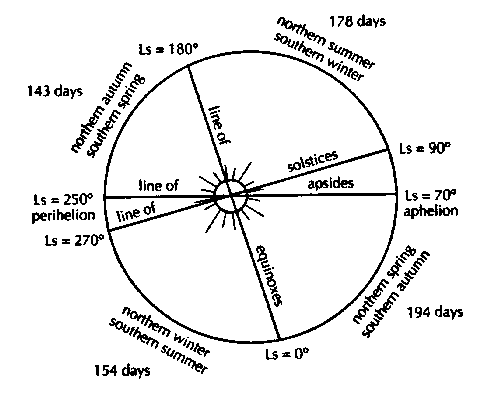An Explanation of Zubrin's Mars Calendar
Paul J. Thomas
Department of Physics and Astronomy
University of Wisconsin - Eau Claire
(715) 836-3615
Note: This page contains material from The Case for Mars, by
Robert Zubrin with Richard Wagner (The Free Press, 1996). This material is
reproduced with permission.
The Problem
A solar day (noon to noon) on Mars is called a Sol. It is quite
similar in length to an Earth day: 24 hours and 39.6 minutes long. To date, the
only sort of calendrical system used by humans on Mars is to number Sols for
each spacecraft we have landed starting at Sol 1 for the landing day. See, for
example, the Mars Pathfinder home
page.
This is clearly unsustainable in the long term, particularly when we start to
settle Mars permanently. We need to develop a calendar system for Mars similar
to that of the Earth. In this system, there would be 669 Sols each year. We need
to figure out a way to organize these into months and to number the years. The
reason that this is non-trivial is (a) Mars's orbit around the Sun is quite
elliptical, so the seasons are of grossly different lengths, and (b) what do we
use as a year zero?
Determining the Months
Unlike Earth, we cannot base the length of a month on the motions of Mars's
satellites. Phobos orbits Mars every 7 hours 39 minutes (a time shorter than a
Sol!), while Deimos orbits Mars every 30 hours 7 minutes. In any case, they do
not dominate Mars's night sky in the same way that that the Moon does Earth's.
Similarly, we cannot just map Earth months to Mars, as they will not fit into
its year. The ellipticity of Mars's orbit, discovered by Johannes Kepler in
1619, is another serious problem, as shown below.

As is clear from the picture above, the various seasons of Mars have markedly
different lengths. For example, winter in the Northern hemisphere is 154 days
long, while winter in the Southern hemisphere is 178 days long. Scientists mark
the first Sol of each year from the Northern spring equinox, and define this
position as the line LS=00. The angles increase as Mars
revolves around the Sun (in an anticlockwise direction as seen from a point
North of the ecliptic plane, as in this diagram). As we can see, at
LS=700, Mars is at aphelion (furthest point from the Sun);
while at LS=2500, Mars is at perihelion (closest point to
the Sun). Dust storms frequently occur around this time (and we have lost
spacecraft in them), so this is a good date to have marked on a Mars calendar!
Robert Zubrin has extended this approach to develop a calendar for months.
The basic idea of this is that the month corresponds to whatever constellation
of the zodiac Mars would appear in as seen from the Sun. This marks the martian
year into a set of 12 more-or-less equal months, as shown in the table below.
The Martian Year
| Month
| Number
of Sols
| Begins
on Sol #
| Noteworthy Features
|
| Gemini
| 61
| 1
| Gemini 1, Vernal equinox
|
| Cancer
| 65
| 62
|
|
| Leo
| 66
| 127
| Leo 24, Mars at Aphelion
|
| Virgo
| 65
| 193
| Virgo 1, Summer solstice
|
| Libra
| 60
| 258
|
| Scorpius
| 54
| 318
|
| Sagittarius
| 50
| 372
| Sagittarius 1, Autumnal equinox
|
| Capricorn
| 47
| 422
| Dust storm season begins
|
| Aquarius
| 46
| 469
| Aquarius 16, Mars at Perihelion
|
| Pisces
| 48
| 515
| Pisces 1, Winter solstice
|
| Aries
| 51
| 563
| Dust storm season ends
|
| Taurus
| 56
| 614
| Taurus 56, Martian New Year's Eve |
 This
table of months is calculated on the main page, using a Javascript
implementation. This
table of months is calculated on the main page, using a Javascript
implementation.
Determining the Year
Determining the year is somewhat simpler. We just need to decide on an agreed
on date for the beginning of our calendar. Zubrin noted that the beginning of
the martian month of Gemini also corresponded to Mars's position around January
1 in the years 1946, 1961, 1976, 1991 and so on. The latest year that precedes
all spacecraft sent to Mars is 1961. Zubrin therefore sets this year to I (he
uses roman numerals).
It's worth noting that this perpetuates the annoying "lack of year zero"
problem of the terrestrial calendar on to Mars.
Important events in the history of our exploration of Mars can be found in
the table below.
Great Dates in Recent Martian History
| Occasion
| Terrestrial Date
| Martian Date
|
| Calendar begins
| January 1, 1961
| Gemini 1, I
|
| Mariner 4 flyby
| July 15, 1965
| Libra 25, III
|
| Mariner 6 flyby
| July 31, 1969
| Sagittarius 16, V
|
| Mariner 7 flyby
| August 5, 1969
| Sagittarius 20, V
|
| Mariner 9 arrival in orbit
| November 14, 1971
| Pisces 20, VI
|
| Mars 2 & 3 landings
| December 2, 1971
| Pisces 38, VI
|
| Viking 1 arrival in orbit
| June 19, 1976
| Leo 41, IX
|
| Viking 1 landing
| July 20, 1976
| Virgo 6, IX
|
| Viking 2 landing
| September 3, 1976
| Virgo 49, IX
|
| Mars Observer lost
| August 21, 1993
| Libra 16, XVII
|
| Mars Pathfinder lands
| July 4, 1997
| Libra 26, XX
|
| Mars Global Surveyor arrives
| September 11, 1997
| Scorpius 33, XX |
|


